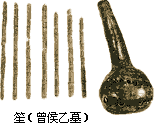Shēng
 Sheng is China’s ancient reed-pipe musical instrument, can produce harmonic sound. The reed can freely vibrate in the frame, therefore, Sheng is the earliest instrument that uses a free reed.
Sheng is China’s ancient reed-pipe musical instrument, can produce harmonic sound. The reed can freely vibrate in the frame, therefore, Sheng is the earliest instrument that uses a free reed.
As far back as Shang Dynasty some 3,000 years ago, there was a rudimentary form of Sheng accroding to the inscriptions on turtle
Sheng in the hands of a celestrial shells excavated from Yin Tombs (1401-1122
In the paintings of Kaiyuan Temple BC). Sheng was already quite popular in the
of Quanzhou periods when the poems in the 《Book of Songs》were composed, as 《The Deer Calls》in the 《Minor Ya》section goes:
“for my honored guests, Se and Sheng were played, a basket of gifts was presented while Sheng and reed were sounding.”
Sheng was very much used in Sui and Tang dynasty musics, there were many famous players of Sheng in the Tang period. It had 13-19 reeds at the time. 14 and 17 reeds ones were most popular. 
In 1978 six ancient Sheng made from gourd were excavated from the Zenghouyi Tomb at Suixian County of Hubei Province as shown on the left. The sounding part is made of gourd, the mouthpiece is made of wood and the shoots are square at the front and round at the back. There are red patterns over the black paint and the pattern is still visible over 2,400 years later. The reeds are made of bamboo, in even numbers, 14, 16 and 18, unlike what was written in ancient books. The shape of reed, the way they were made and the way of tuning are the same with today’s copper reed.
In Zhihua Temple of Beijing, there is one Sheng with 17 reeds and 17 pipes, the sounding part is made of ox horn, 8 cm high with a diameter of 8.5 cm, the instrument is 51 cm in height. The temple was built in the Ming Dynasty by a eunuch. However, there has always been a bench of musician monks, among its existing scores, one was copied by the 15th generation monk Yongqian in 1694 is the earliest. Because the monks are strict in passing down their knowledge, their way of playing is most likely the actual way used during the Ming period.
Sheng was passed to Japan during Tang Dynasty, in Shosoin of Todaiji in Nara, Japan, there are two “Sheng”s with 17 reeds and 17 pipes. In 1777, a French missionary Jean Joseph Marie Amoit braught a Sheng to France when he was having annual leave from China; in 1780, a Danish pipe organ manufacturer Kosnic who lived for sometime in Russia adopted the free reed onto pipe organs.
Structure of a Sheng: it is composed of a sounding part,mouth-piece, pipes
(shoots), reed holder, reeds and bounding on the body.

Famous Sheng pieces:
《Rainbrow》
《Peacock》
《White Snake Fantasy》
《Princess Wencheng》
《The Quiet Night》
《The Sheng Songs》
《Pheonix Opens up Wings》
